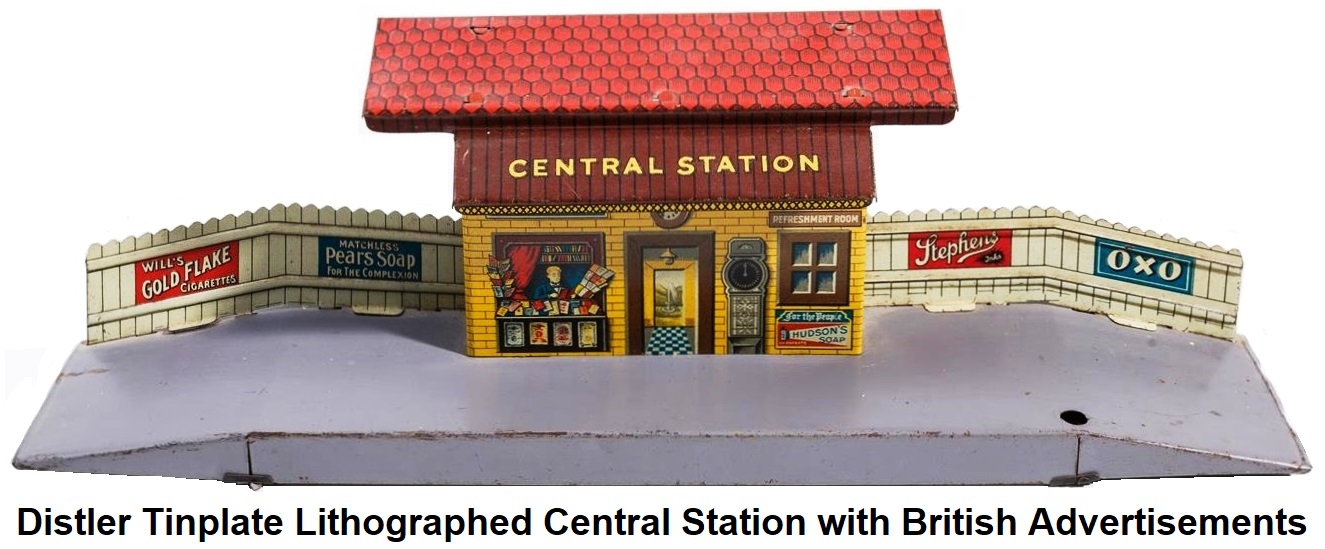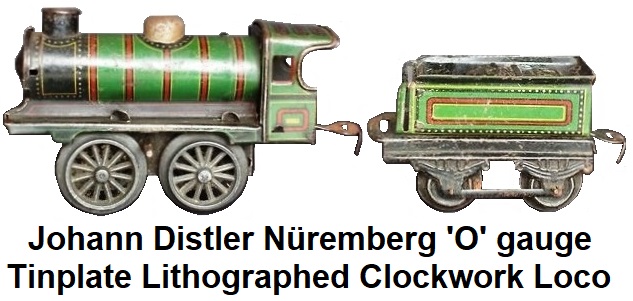 The Johann Distler KG metalware factory was founded in Nüremberg, Germany around 1900.
Incorporation took place on August 16, 1909 by Johann Distler and Käthe Distler. The company operated through 1968 in
various forms and under different management. Between 1926 and 1968, about 86 German patents were awarded to Distler
(11 specifically for toy train designs, 24 for mechanical motors, electric / remote controls). The first products
manufactured until the breakout of World War I were
lithographed tin penny toys and other action transportation toys. The most famous one was a street organ player.
After the war, aircraft, mechanical figures, clockwork and electric trains in 'O' and HO gauges, and electric toy cars were
made. Starting in 1955 Distler produced their detailed electric model of the Porsche 356, for which they became well known
by model automobile collectors. During the 1950's and 60's Distler also produced two battery-powered electric shavers: the
Piccalo and the Tourist. Distler was one of the first toy manufacturers to complete a licensing deal with Walt Disney.
The Johann Distler KG metalware factory was founded in Nüremberg, Germany around 1900.
Incorporation took place on August 16, 1909 by Johann Distler and Käthe Distler. The company operated through 1968 in
various forms and under different management. Between 1926 and 1968, about 86 German patents were awarded to Distler
(11 specifically for toy train designs, 24 for mechanical motors, electric / remote controls). The first products
manufactured until the breakout of World War I were
lithographed tin penny toys and other action transportation toys. The most famous one was a street organ player.
After the war, aircraft, mechanical figures, clockwork and electric trains in 'O' and HO gauges, and electric toy cars were
made. Starting in 1955 Distler produced their detailed electric model of the Porsche 356, for which they became well known
by model automobile collectors. During the 1950's and 60's Distler also produced two battery-powered electric shavers: the
Piccalo and the Tourist. Distler was one of the first toy manufacturers to complete a licensing deal with Walt Disney.
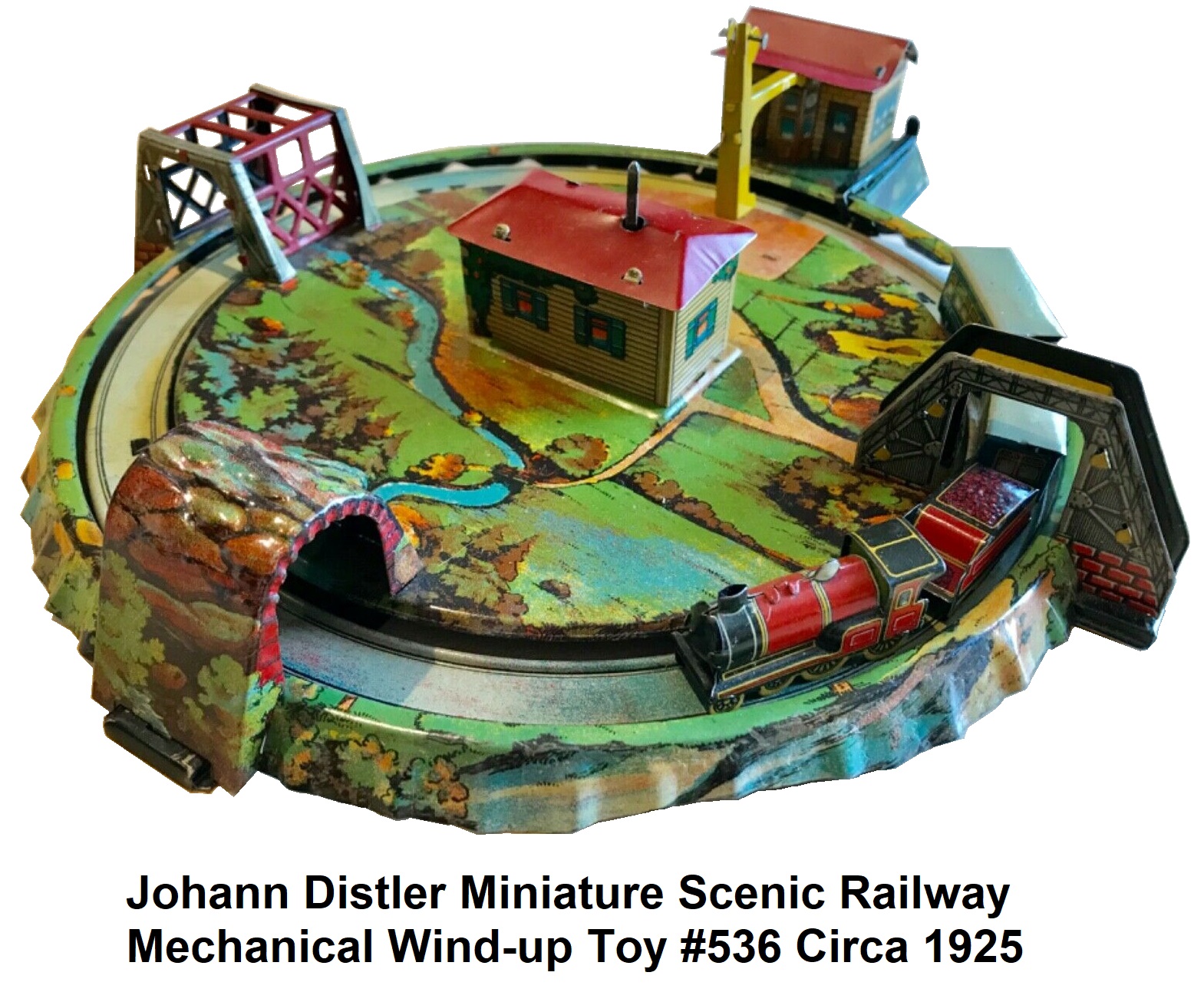
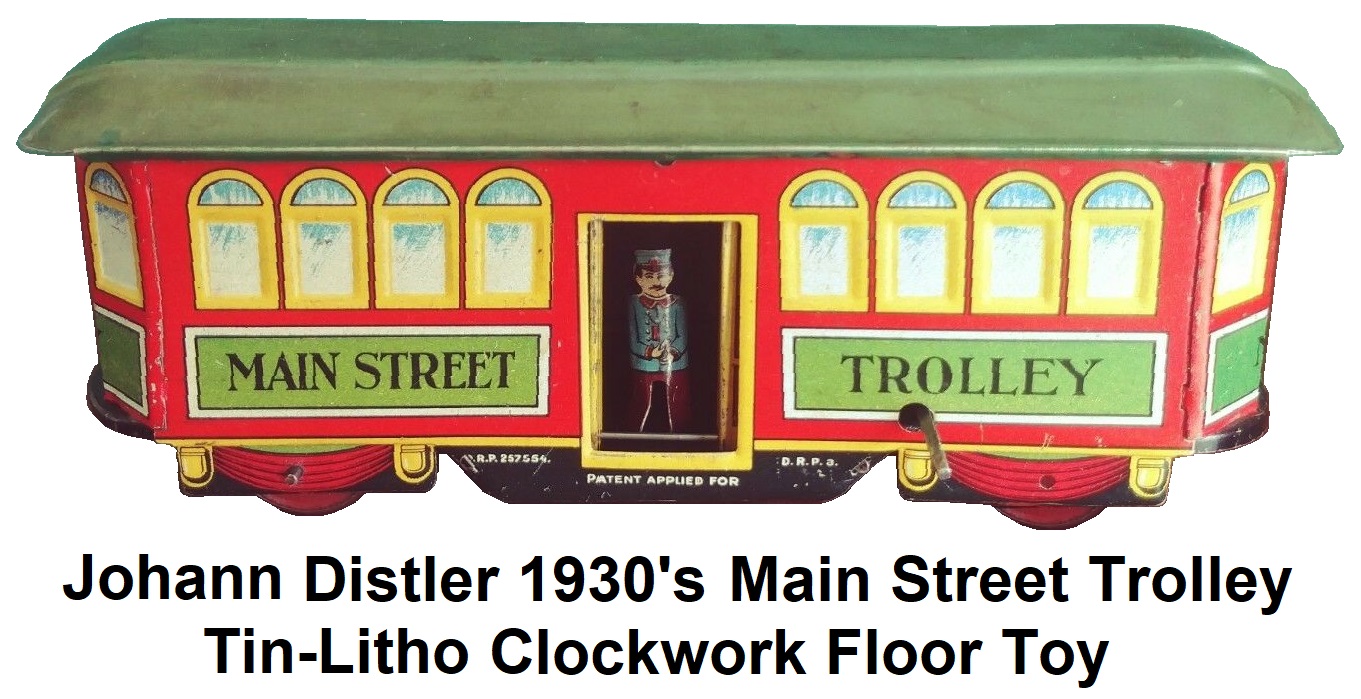 On November 28, 1917, Distler brought in Nüremberg merchants Adolf Braun and Joseph Meyer as partners.
Another merchant, Siegmund Heussinger from Schweinfurt was also brought on as a partner. Each shareholder was entitled to
an equal share and could represent and sign alone. In the 1920's and 30's, Distler
greatly expanded both in terms of workforce and products, making some excellent cars and beginning to expand into
clockwork mechanisms. After Distler`s death in 1923, his partners took over the business. On January 25, 1923,
businessman Ludwig Meyer was registered as a further shareholder. Joseph Meyer passed away December 22, 1924.
On January 14, 1926 shareholder Siegmund Heussinger passed away and in his place Doctor Ludwig Heussinger of Schweinfurt
became a full shareholder. In 1935 the company was forced to change ownership completely. The owners Braun & Meyer were Jewish
and were forced to sell the company as the German Aryanization laws mandated no Jewish ownership of companies.
On December 24, 1935 it was sold to Ernst Voelk who also later took over Trix in April 1938.
On November 28, 1917, Distler brought in Nüremberg merchants Adolf Braun and Joseph Meyer as partners.
Another merchant, Siegmund Heussinger from Schweinfurt was also brought on as a partner. Each shareholder was entitled to
an equal share and could represent and sign alone. In the 1920's and 30's, Distler
greatly expanded both in terms of workforce and products, making some excellent cars and beginning to expand into
clockwork mechanisms. After Distler`s death in 1923, his partners took over the business. On January 25, 1923,
businessman Ludwig Meyer was registered as a further shareholder. Joseph Meyer passed away December 22, 1924.
On January 14, 1926 shareholder Siegmund Heussinger passed away and in his place Doctor Ludwig Heussinger of Schweinfurt
became a full shareholder. In 1935 the company was forced to change ownership completely. The owners Braun & Meyer were Jewish
and were forced to sell the company as the German Aryanization laws mandated no Jewish ownership of companies.
On December 24, 1935 it was sold to Ernst Voelk who also later took over Trix in April 1938.

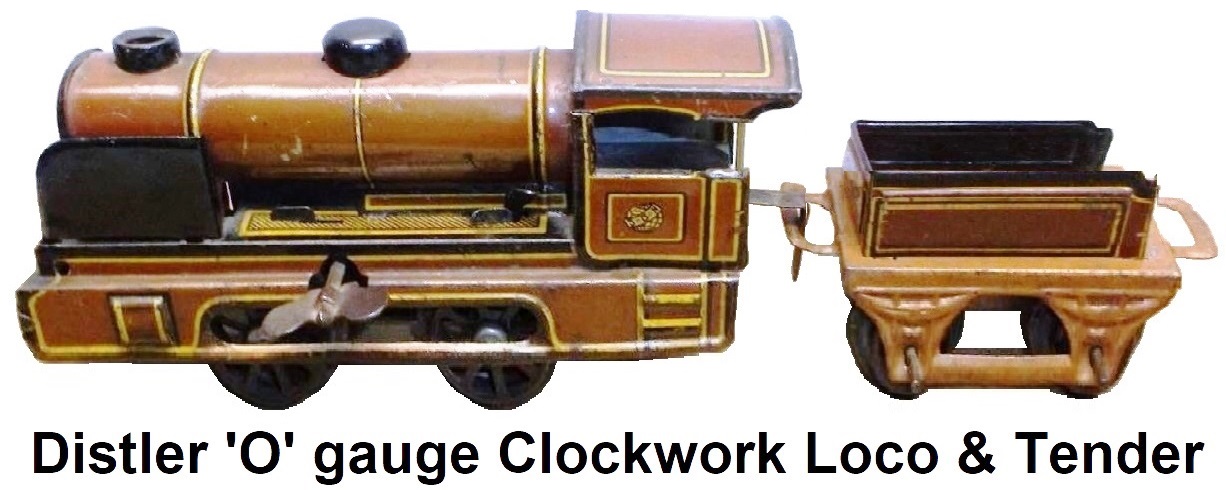 Ernst Voelk (1896 - 1969) was born in Fürth, Bavaria. He was a second generation toy manufacturer,
having gotten involved with his father, Thomas Voelk's company in 1921. After his father's passing he assumed management
of that company. Ernst Voelk became a leader in Adolf Hitler's 3rd Reich as head of section S - toys, sporting goods and
gymnastic equipment of the iron and metal industry group. He was also leader of the Reich Association of German toy industry
and the Nuremberg-Fürth toy industry and leader of the Association of Bavarian play and metal goods manufacturers. The
production programs of the two companies he assumed management of - Johann Distler KG Nuremberg and Trix Vereinigte
Spielwarenfabriken GmbH, had points of contact but no direct interfaces. Distler produced sheet metal vehicles, tin toys and
assorted railways for department stores and mail order while Trix continued to produce the higher quality 'OO'/HO gauge model
trains (later also N gauge) and the Trix metal construction kits. There is one known collaboration between Distler and Trix
that took place just after the end of World War II where a small, powerful electric motor developed by Distler was also used
in the Trix Express battery powered locomotives and in the Trix Twin Cadet Locos. Over his lifetime, Ernst Voelk obtained 14
different patents for various mechanical toys, improvements to electric motors, music box mechanisms, magnetic recording and
reproduction methods, and methods for controlling the speed of electric motors. These patents were registered in Austria,
Belgium, Switzerland, Germany, England and the United States.
Ernst Voelk (1896 - 1969) was born in Fürth, Bavaria. He was a second generation toy manufacturer,
having gotten involved with his father, Thomas Voelk's company in 1921. After his father's passing he assumed management
of that company. Ernst Voelk became a leader in Adolf Hitler's 3rd Reich as head of section S - toys, sporting goods and
gymnastic equipment of the iron and metal industry group. He was also leader of the Reich Association of German toy industry
and the Nuremberg-Fürth toy industry and leader of the Association of Bavarian play and metal goods manufacturers. The
production programs of the two companies he assumed management of - Johann Distler KG Nuremberg and Trix Vereinigte
Spielwarenfabriken GmbH, had points of contact but no direct interfaces. Distler produced sheet metal vehicles, tin toys and
assorted railways for department stores and mail order while Trix continued to produce the higher quality 'OO'/HO gauge model
trains (later also N gauge) and the Trix metal construction kits. There is one known collaboration between Distler and Trix
that took place just after the end of World War II where a small, powerful electric motor developed by Distler was also used
in the Trix Express battery powered locomotives and in the Trix Twin Cadet Locos. Over his lifetime, Ernst Voelk obtained 14
different patents for various mechanical toys, improvements to electric motors, music box mechanisms, magnetic recording and
reproduction methods, and methods for controlling the speed of electric motors. These patents were registered in Austria,
Belgium, Switzerland, Germany, England and the United States.




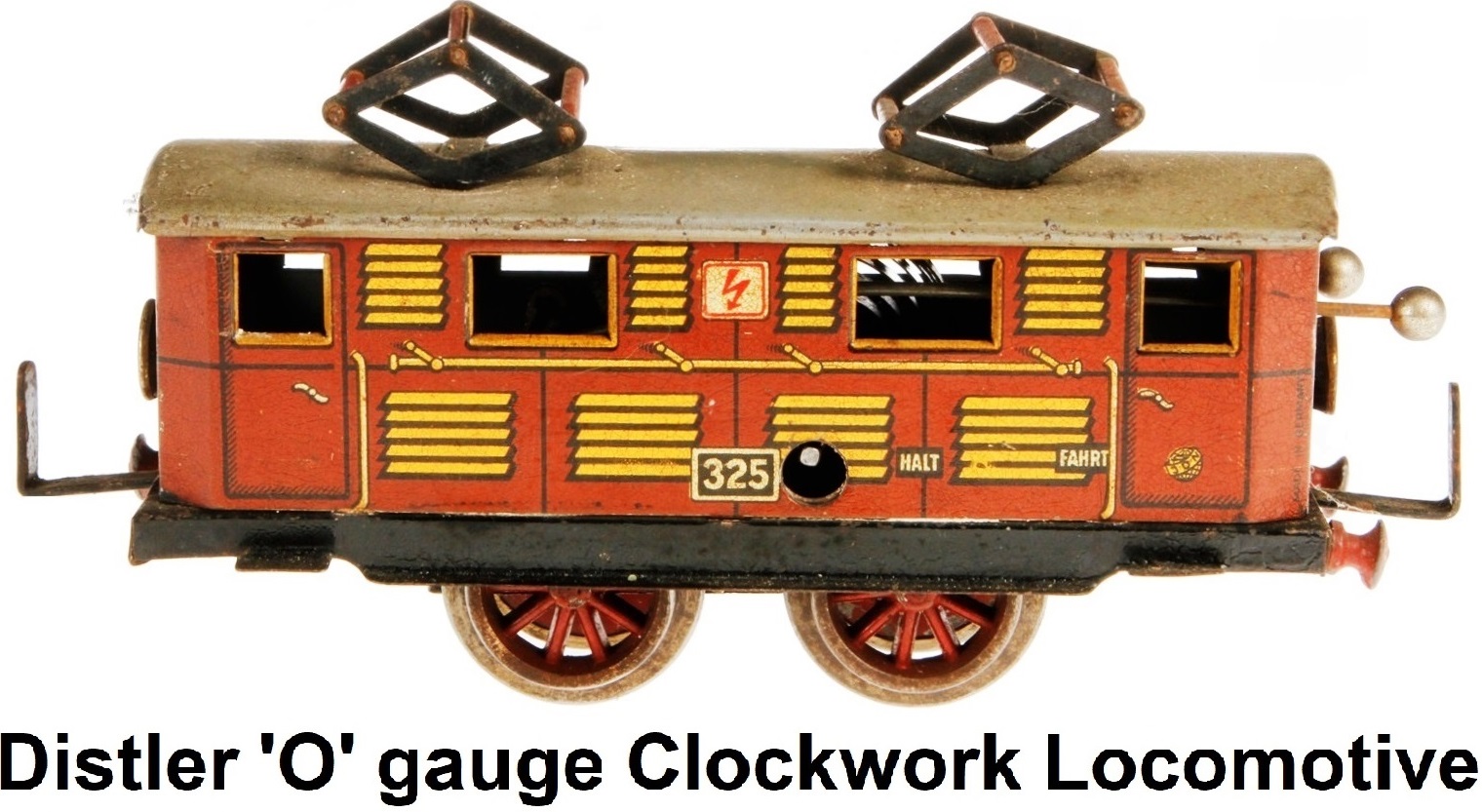 In the years between the First and Second World War, the number of Distler employees rose from 50 to 120,
and the product range included 800 different items. The Distler 1928 catalog was printed in color and published in German,
English, French and Spanish language versions. It featured the entire production range of tin toy cars, railways, aircraft,
canons, and mechanical tin toys of all types illustrated across 90 pages. The earliest Distler trains were clockwork
powered. They came in either passenger or freight sets that typically included a loop of 2-rail 'O' gauge tubular steel track.
These sets came in cardboard boxes adorned with elaborate illustrations that depicted a real train, typically the
prototype of the train contained in the set. The earliest electric sets issued by Distler appear to have been designed
to operate on special 2-rail insulated 'O' gauge tubular steel track and were powered using 4.5 volt's. The power was supplied
to the track via wires that were connected to a small plastic box that housed 3 1.5 volt batteries and allowed limited control
of the train's speed. Sets were produced for export to the North American markets, and included familiar road names such as
Santa Fe and New York Central. A rare Canadian Pacific passenger set is also known to exist. Distler was one of the
many train manufacturers that also manufactured their own 'O' gauge tubular steel track.
In the years between the First and Second World War, the number of Distler employees rose from 50 to 120,
and the product range included 800 different items. The Distler 1928 catalog was printed in color and published in German,
English, French and Spanish language versions. It featured the entire production range of tin toy cars, railways, aircraft,
canons, and mechanical tin toys of all types illustrated across 90 pages. The earliest Distler trains were clockwork
powered. They came in either passenger or freight sets that typically included a loop of 2-rail 'O' gauge tubular steel track.
These sets came in cardboard boxes adorned with elaborate illustrations that depicted a real train, typically the
prototype of the train contained in the set. The earliest electric sets issued by Distler appear to have been designed
to operate on special 2-rail insulated 'O' gauge tubular steel track and were powered using 4.5 volt's. The power was supplied
to the track via wires that were connected to a small plastic box that housed 3 1.5 volt batteries and allowed limited control
of the train's speed. Sets were produced for export to the North American markets, and included familiar road names such as
Santa Fe and New York Central. A rare Canadian Pacific passenger set is also known to exist. Distler was one of the
many train manufacturers that also manufactured their own 'O' gauge tubular steel track.

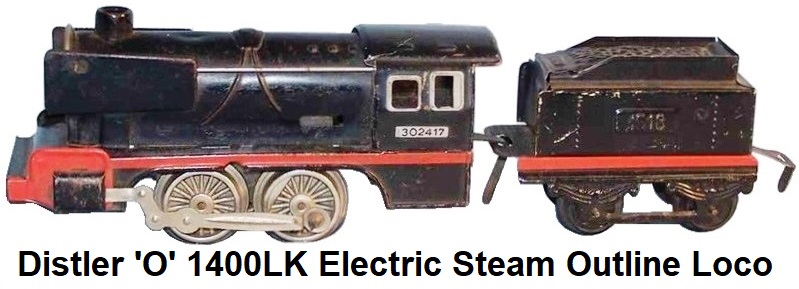
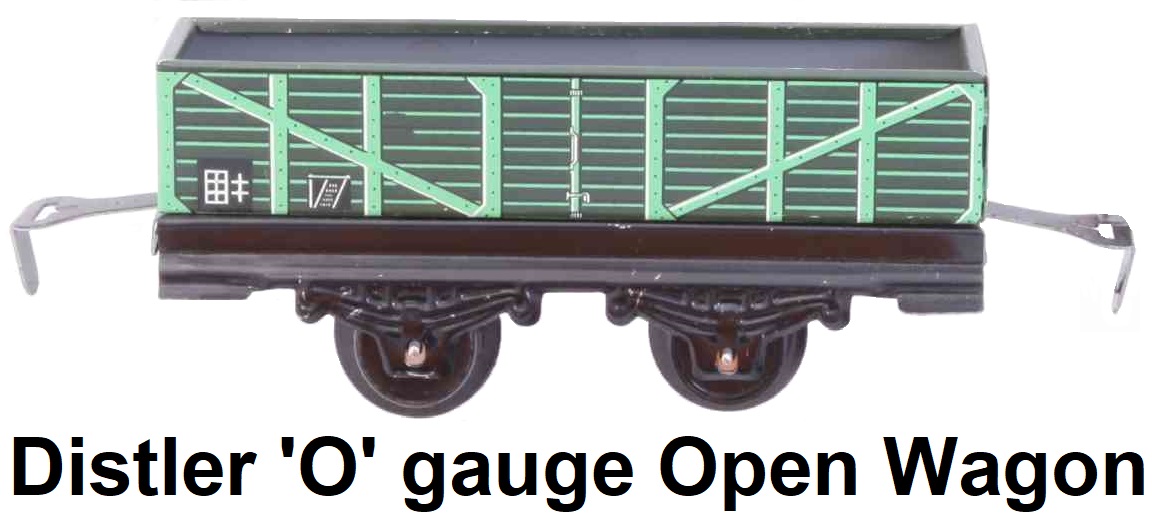
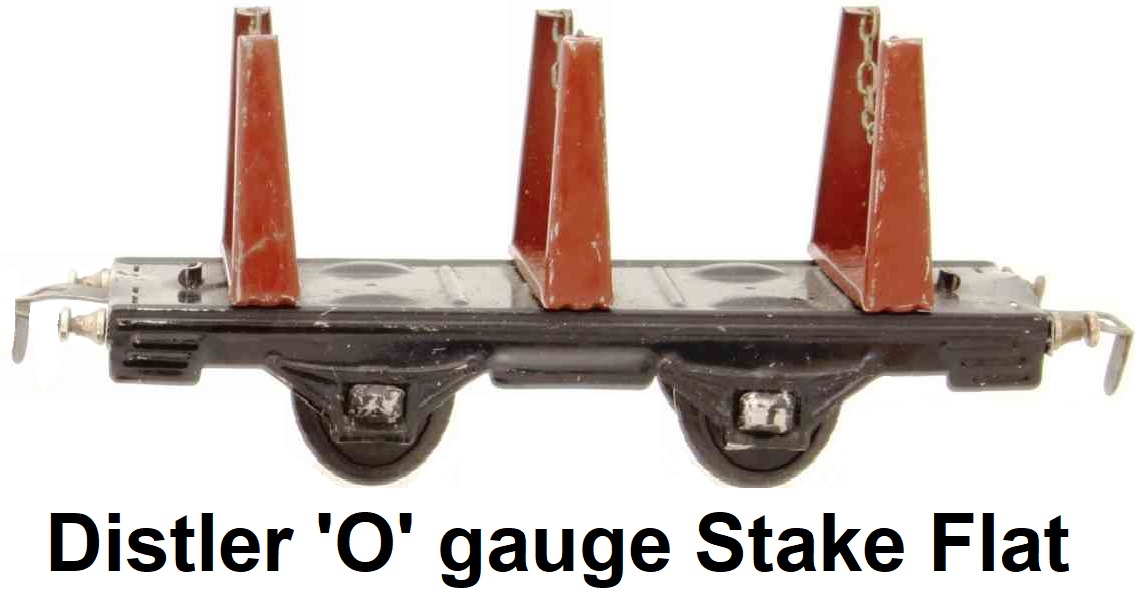
 From 1939 until the end of World War II, many
toy factories in Germany stopped production and were converted to help manufacture goods for the war effort. Distler
produced aircraft and auto parts during these years. The Distler factory was 85% destroyed from allied bombing during
World War II. After the war, the factory was rebuilt (1948-53) and Distler returned to production of toys. Their factory
was in the U.S. Zone and the toys made from 1945 to 1949 were marked 'U.S. Zone Germany'. After then the Distler trains
and toys were marked as 'Made in Western Germany'.
From 1939 until the end of World War II, many
toy factories in Germany stopped production and were converted to help manufacture goods for the war effort. Distler
produced aircraft and auto parts during these years. The Distler factory was 85% destroyed from allied bombing during
World War II. After the war, the factory was rebuilt (1948-53) and Distler returned to production of toys. Their factory
was in the U.S. Zone and the toys made from 1945 to 1949 were marked 'U.S. Zone Germany'. After then the Distler trains
and toys were marked as 'Made in Western Germany'.


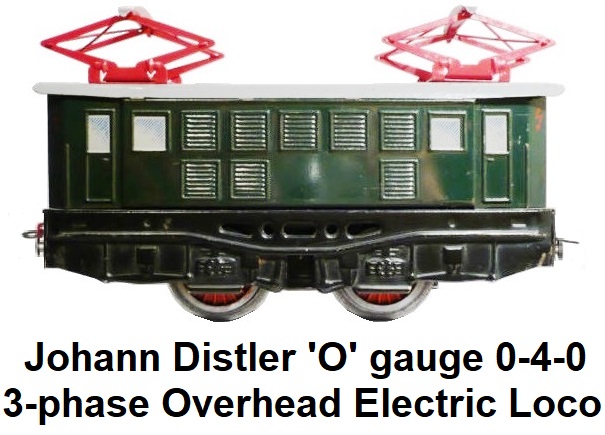 In 1952 Distler introduced an unusual and unique 3-phase electric power system for part of their 'O' gauge line. It consisted
of locomotives running on conventional 3-rail tubular steel track, but with all three rails insulated from each other and
separately powered by a special transformer/controller built by Siemens-Schuckert, and sold separately. The special track is
easily identifiable as the 2 outer rails are insulated from the ties/sleepers, but the center rail is not. The 14 volt output
to the track came from three phases that were split 90/90/180 rather than the more conventional 120/120/120, and the AC motors
fitted into the locomotives were believed to be war surplus. These special transformers plugged into regular single phase 220
volt or 110 volt wall outlets, and then via 3 separate terminals on the output side - two that were tapped directly into the
secondary winding to provide the first 2 phases and one that was fed through a capacitor that performed the 90 degree phase
shift to supply the 3rd phase, created the track power. The Siemens-Schuckert power pack was fitted with a knob that
facilitated regulation of the output voltage and thus the speed of the locomotives. Because of the 3 phase supply, when the
transformer knob remained in the neutral position, the locomotive headlights were illuminated. The device also was equipped
with a lever that was utilized to reverse the phasing, and thus resulted in reversing the direction of travel of a locomotive.
The range consisted of two steam outline locos and two overhead electric locos (one was an E94 Crocodile type), with three
freight cars and three passenger cars, all tin-ltho construction. Both locos and rolling stock are easily identified by the
unique couplings, each of which was designed to hook under the buffer beam of the adjoining car, rather than to an adjoining
coupling. The buffers utilized had a very short shank, to avoid buffer lock. The buffer shanks on the front of the steam loco
are longer, where no coupling is fitted.
In 1952 Distler introduced an unusual and unique 3-phase electric power system for part of their 'O' gauge line. It consisted
of locomotives running on conventional 3-rail tubular steel track, but with all three rails insulated from each other and
separately powered by a special transformer/controller built by Siemens-Schuckert, and sold separately. The special track is
easily identifiable as the 2 outer rails are insulated from the ties/sleepers, but the center rail is not. The 14 volt output
to the track came from three phases that were split 90/90/180 rather than the more conventional 120/120/120, and the AC motors
fitted into the locomotives were believed to be war surplus. These special transformers plugged into regular single phase 220
volt or 110 volt wall outlets, and then via 3 separate terminals on the output side - two that were tapped directly into the
secondary winding to provide the first 2 phases and one that was fed through a capacitor that performed the 90 degree phase
shift to supply the 3rd phase, created the track power. The Siemens-Schuckert power pack was fitted with a knob that
facilitated regulation of the output voltage and thus the speed of the locomotives. Because of the 3 phase supply, when the
transformer knob remained in the neutral position, the locomotive headlights were illuminated. The device also was equipped
with a lever that was utilized to reverse the phasing, and thus resulted in reversing the direction of travel of a locomotive.
The range consisted of two steam outline locos and two overhead electric locos (one was an E94 Crocodile type), with three
freight cars and three passenger cars, all tin-ltho construction. Both locos and rolling stock are easily identified by the
unique couplings, each of which was designed to hook under the buffer beam of the adjoining car, rather than to an adjoining
coupling. The buffers utilized had a very short shank, to avoid buffer lock. The buffer shanks on the front of the steam loco
are longer, where no coupling is fitted.
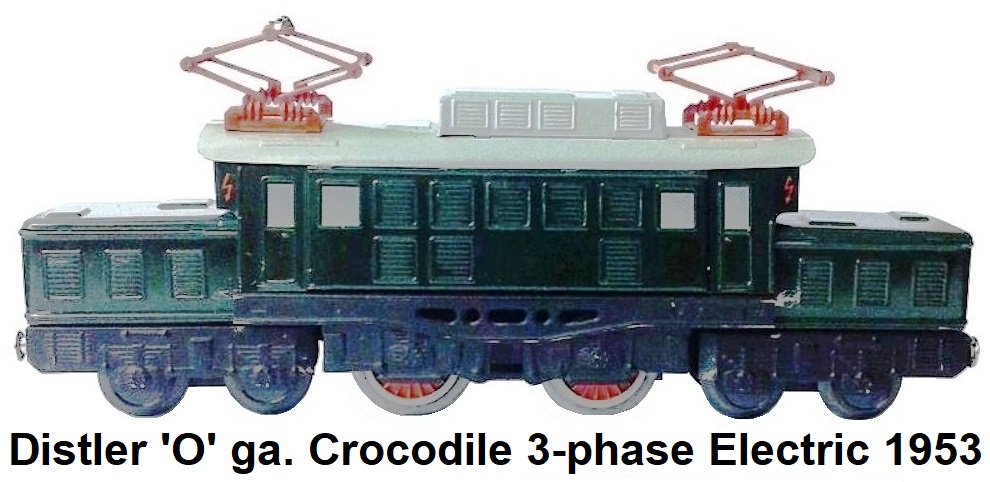

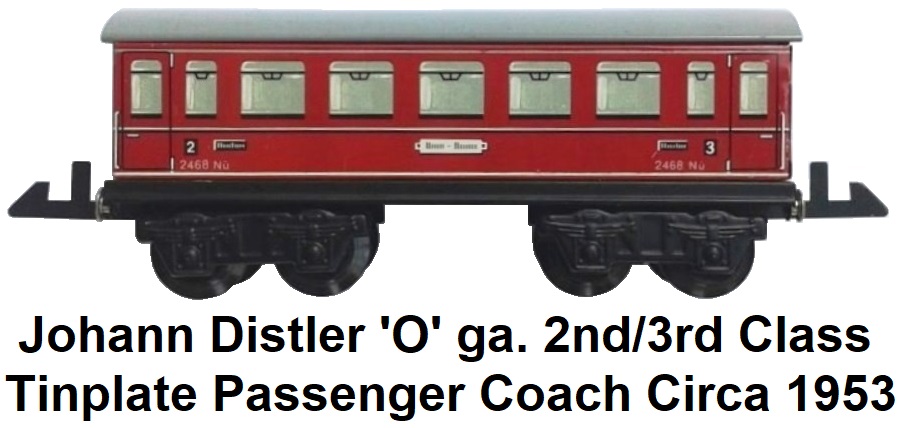 By 1955 the product line had been reduced in size and the Distler catalog was only 46 pages long.
Starting in 1957 Distler began to switch from making 'O' gauge railway models in favor of HO scale. These
were simple sheet metal trains that ran on 3-volt battery power using a similar control mechanism as the electric
'O' gauge trains utilized. Franz Carl Weber (Switzerland) and Jelmoli (Switzerland)
showed the first Distler HO trains in their catalogs in the same year. The German mail-order companies Quelle, Neckermann,
Schöpflin sold Distlerbahnen from 1959 onwards. The track material used is described differently in various product reviews.
K. P. Huschka described it as being the cardboard sleeper based track from Trix Express, whereas Dieter Käßer wrote
that the rails were purchased from Fleischmann. The first HO gauge train sets issued by
Distler were each packaged in cardboard boxes that had individually designed and illustrated images on the lids depicting
the trains that were included in the set. Additional passenger cars could be purchased in 3-car add-on sets.
By 1955 the product line had been reduced in size and the Distler catalog was only 46 pages long.
Starting in 1957 Distler began to switch from making 'O' gauge railway models in favor of HO scale. These
were simple sheet metal trains that ran on 3-volt battery power using a similar control mechanism as the electric
'O' gauge trains utilized. Franz Carl Weber (Switzerland) and Jelmoli (Switzerland)
showed the first Distler HO trains in their catalogs in the same year. The German mail-order companies Quelle, Neckermann,
Schöpflin sold Distlerbahnen from 1959 onwards. The track material used is described differently in various product reviews.
K. P. Huschka described it as being the cardboard sleeper based track from Trix Express, whereas Dieter Käßer wrote
that the rails were purchased from Fleischmann. The first HO gauge train sets issued by
Distler were each packaged in cardboard boxes that had individually designed and illustrated images on the lids depicting
the trains that were included in the set. Additional passenger cars could be purchased in 3-car add-on sets.

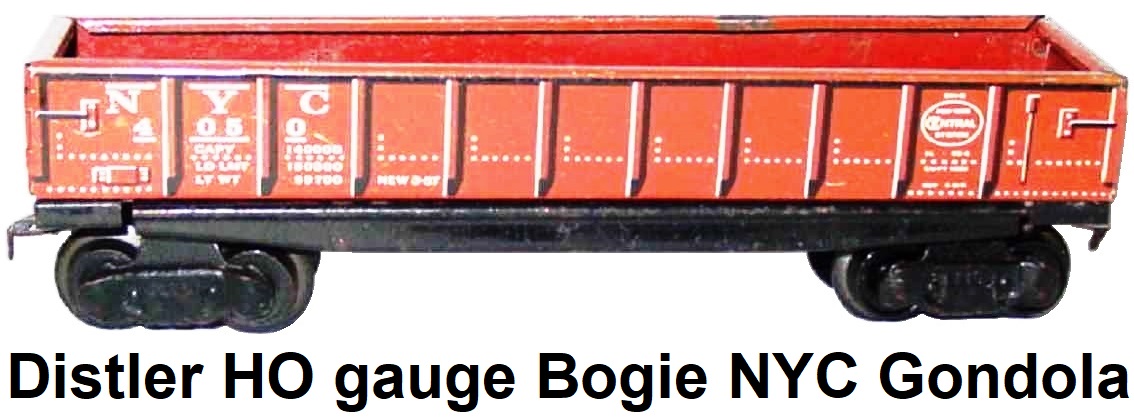
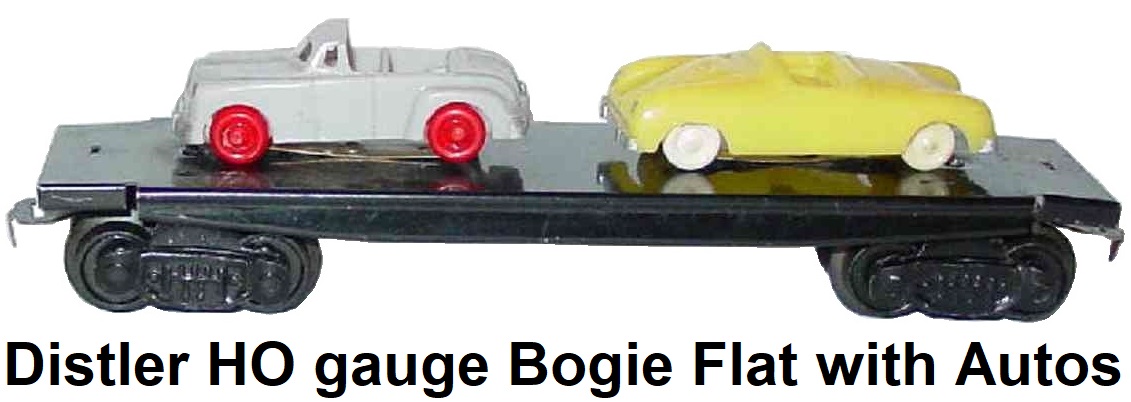
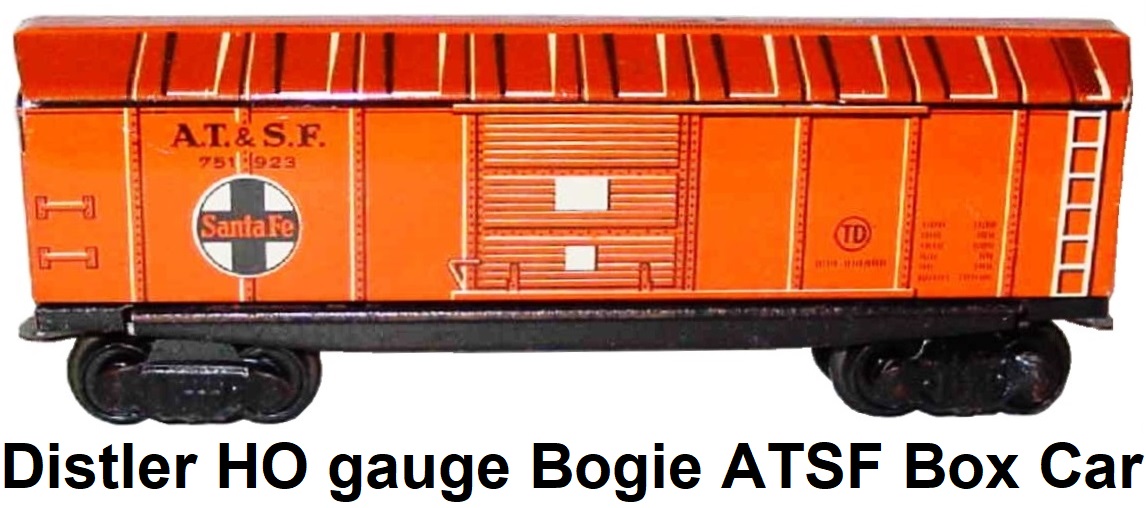

The HO gauge train sets issued by Distler were:
#501 TD 5000 - 2 car train from 1957
#502 TD 5000 - 3 car train from 1957
#503 Santa Fe passenger train - combo car and two coaches with 4 axles from 1957
#504 Santa Fe Freight train - three US freight cars with 4 axles from 1957
#505 Br 80 passenger train - baggage van and two coaches with 2 axles from 1958
#506 Br 80 Freight train - open wagon, Shell tanker and closed van with 2 axles from 1958
#507 V 200 Touropa Express - three blue TOUROPA wagons with 4 axles from 1958
#508 Br 01 D-train - baggage van, DSG dining car and 1st/2nd class coach with 4 axles from 1958
#509 E 44 passenger train - baggage van, two passenger cars with 2 axles from 1959
#510 E 44 Freight train - open wagon, Shell tanker and closed van with 2 axles from 1959
#511 VT 11.5 four-piece TEE railcar from 1959
#512 US Switcher blue-gray diesel loco, blue gondola, yellow box car, red caboose from 1960
#600 tram with two sidecars (red or yellow)



Changes in market conditions led to financial problems for Johann Distler KG in the late 1950's as the
company's products could not compete against larger German manufacturers such as
Schuco and Märklin. Additional restrictions on the ability for
Distler to compete for consumers and innovate were put in place merely by the fact that they could not produce
anything already covered by the German Trix range. Demand for the cheap tinplate toy railways with clockwork and battery
powered drives fell and production of Distler toys and models in Germany was discontinued in 1962. The company, along with its
patents, rights, tooling and machinery was acquired by a firm in Belgium, where Distler Toys S.A. in Nivelles continued
business under the Distler brand name until 1968. The Belgium company Distler Toys S.A. continued to manufacture some of
the HO railway models and the famous Distler Porsche using the original tools. The Distler TEE was produced almost unchanged.
Models were stamped 'Made in Belgium' on the bogies. The Trans European Express set (TEE) continued to be
distributed by Quelle, and remained in the Quelle catalog until 1964/65 under the old order #11977. By 1963 the Distler Toys
S.A. catalog was a mere 15 pages long.



A very special Belgian variant of the former Distler BR 01 loco was created to solve a problem. The wheels
of the original Distler BR 01 were supplied by Trix. Distler Toys S.A. had only bought up the former Distler forms. To solve
the problem with lack of drivers, the complete 'B' suspension of the small Distler/Trix Bateriedampflok was built into
the BR 01. This Belgian BR 01 thus had a 2'B'1 wheel alignment. As with many Distler Toys S.A. trains, the lithograph did not
change, so the locomotive bore 'Made in Western Germany' while the tender bogies, were stamped 'Made in
Belgium'. The #512 US freight train produced by Distler Germany that featured an S type diesel switcher was made for export
only to America by Cragstan. Cragstan was the distributor for the Distler HO trains in America. During the Belgian years
the set was made available in a new color scheme. This was one of the few items that Distler made using molded plastic
bodies instead of lithographed tinplate.
In 2003 Schuco began manufacturing 1:24 scale metal figures under the
Distler brand name, the majority of which were military. Schuco had acquired GAMA in 1993, and GAMA had previously
acquired German Trix in 1971. It is believed that Schuco obtained the Distler trademarks in that acquisition, and had kept
them after the sale of Trix to Märklin in 1997.
